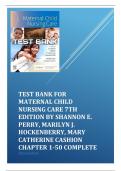TEST BANK FOR
MATERNAL CHILD
NURSING CARE 7TH
EDITION BY SHANNON E.
PERRY, MARILYN J.
HOCKENBERRY, MARY
CATHERINE CASHION
CHAPTER 1-50 COMPLETE
2023 verified
,Chapter 01: 21st Century Maternity Nursing
Perry: Maternal Child Nursing Care, 7th Edition
MULTIPLE CHOICE
1. When providing care for a pregnant woman, the nurse should be aware that one of the most
frequently reported maternal medical risk factors is a. diabetes mellitus.
b. mitral valve prolapse (MVP).
c. chronic hypertension.
d. anemia.
ANS: A
The most frequently reported maternal medical risk factors are diabetes and hypertension
associated with pregnancy. Both of these conditions are associated with maternal obesity.
There are no studies that indicate MVP is among the most frequently reported maternal risk
factors. Hypertension associated with pregnancy, not chronic hypertension, is one of the most
frequently reported maternal medical risk factors. Although anemia is a concern in pregnancy,
it is not one of the most frequently reported maternal medical risk factors in pregnancy.
DIF: Cognitive Level: Knowledge OBJ: Nursing Process: Assessment
MSC: Client Needs: Physiologic Integrity
2. To ensure optimal outcomes for the patient, the contemporary maternity nurse must
incorporate both teamwork and communication with clinicians into care delivery. The SBAR
technique of communication is an easy-to-remember mechanism for communication. Which
of the following correctly defines this acronym? a. Situation, baseline assessment, response
b. Situation, background, assessment, recommendation
c. Subjective background, assessment, recommendation
d. Situation, background, anticipated recommendation
ANS: B
The situation, background, assessment, recommendation (SBAR) technique provides a
specific framework for communication among health care providers. Failure to communicate
is one of the major reasons for errors in health care. The SBAR technique has the potential to
serve as a means to reduce errors.
DIF: Cognitive Level: Comprehension
OBJ: Nursing Process: Assessment | Nursing Process: Planning
MSC: Client Needs: Safe and Effective Care Environment
3. The role of the professional nurse caring for childbearing families has evolved to emphasize
a. providing care to patients directly at the bedside.
b. primarily hospital care of maternity patients.
c. practice using an evidence-based approach.
d. planning patient care to cover longer hospital stays.
ANS: C
, Professional nurses are part of the team of health care providers who collaboratively care for
patients throughout the childbearing cycle. Providing care to patients directly at the bedside is
one of the nurse‘s tasks; however, it does not encompass the concept of the evolved
professional nurse. Throughout the prenatal period, nurses care for women in clinics and
physician‘s offices and teach classes to help families prepare for childbirth. Nurses also care
for childbearing families in birthing centers and in the home. Nurses have been critically
important in developing strategies to improve the well-being of women and their infants and
have led the efforts to implement clinical practice guidelines using an evidence-based approach. Maternity
patients have experienced a decreased, rather than an increased, length of stay over the past
two decades.
DIF: Cognitive Level: Comprehension OBJ: Nursing Process:
Implementation MSC: Client Needs: Safe and Effective Care Environment
4. During a prenatal intake interview, the nurse is in the process of obtaining an initial
assessment of a 21-year-old Hispanic patient with limited English proficiency. It is important
for the nurse to
a. use maternity jargon in order for the patient to become familiar with these terms.
b. speak quickly and efficiently to expedite the visit.
c. provide the patient with handouts.
d. assess whether the patient understands the discussion.
ANS: D
Nurses contribute to health literacy by using simple, common words; avoiding jargon; and
evaluating whether the patient understands the discussion. Speaking slowly and clearly and
focusing on what is important increase understanding. Most patient education materials are
written at too high a level for the average adult and may not be useful for a patient with
limited English proficiency.
DIF: Cognitive Level: Application OBJ: Nursing Process: Evaluation MSC:
Client Needs: Health Promotion and Maintenance
5. A 23-year-old African-American woman is pregnant with her first child. Based on the
statistics for infant mortality, which plan is most important for the nurse to implement? a.
Perform a nutrition assessment.
b. Refer the woman to a social worker.
c. Advise the woman to see an obstetrician, not a midwife.
d. Explain to the woman the importance of keeping her prenatal care appointments.
ANS: D
Consistent prenatal care is the best method of preventing or controlling risk factors associated
with infant mortality. Nutritional status is an important modifiable risk factor, but a nutrition
assessment is not the most important action a nurse should take in this situation. The patient
may need assistance from a social worker at some time during her pregnancy, but a referral to
a social worker is not the most important aspect the nurse should address at this time. If the
woman has identifiable high-risk problems, her health care may need to be provided by a
physician. However, it cannot be assumed that all African-American women have high risk
issues. In addition, advising the woman to see an obstetrician is not the most important aspect
on which the nurse should focus at this time, and it is not appropriate for a nurse to advise or
manage the type of care a patient is to receive.
DIF: Cognitive Level: Application OBJ: Nursing Process: Planning MSC:
Client Needs: Health Promotion and Maintenance
, 6. When managing health care for pregnant women at a prenatal clinic, the nurse should
recognize that the most significant barrier to access to care is the pregnant woman‘s a. age.
b. minority status.
c. educational level.
d. inability to pay.
ANS: D
The most significant barrier to health care access is the inability to pay for services; this is
compounded by the fact that many physicians refuse to care for women who cannot pay.
Although adolescent pregnant patients statistically receive less prenatal care, age is not the




